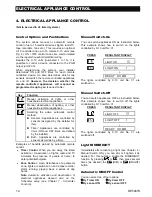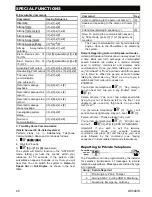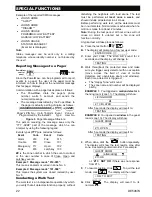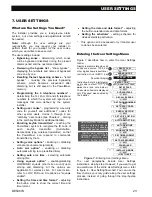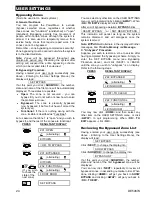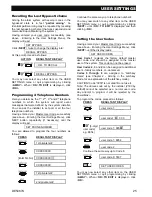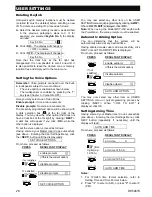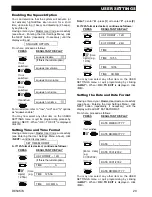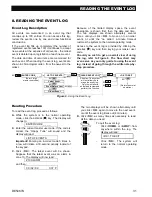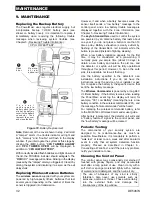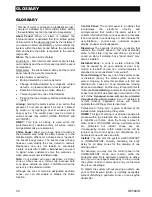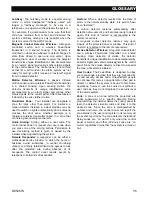
SPECIAL FUNCTIONS
20
DE5467U
B. Executable Commands
Command Keying
Sequence
Disarming
[ ] [1] [#]
Arming Home
[ ] [2] [#]
Arming Home-Instant
[ ] [2]
[
1] [#]
Arming Away
[ ] [3] [#]
Arming Away-Instant
[ ] [3] [1] [#]
Arming Away-Latchkey
[ ] [4] [#]
Arming Away-Instant-
Latchkey
[ ] [4]
[
1] [#]
Elect. Devices (No. 01-
15) ON
[ ] [5] [device No.] [1]
[
#]
Elect. Devices (No. 01-
15) OFF
[ ] [5] [device No.] [0]
[
#]
Activating PGM output
[ ] [5] [0] [0] [1] [#]
Deactivating PGM output [ ] [5] [0] [0] [0] [#]
Two-way voice
communication
(see sub-par. C)
[ ] [7]
[
#]
Recorded message
playback
[ ] [8]
[
1
]
[#]
Recorded message start
record
[ ] [8]
[
2
]
[#]
Recorded message stop
record
[ ] [8]
[
3
]
[#]
Recorded message
erase message
[ ] [8]
[
4
]
[#]
Investigating system
status
[ ] [9] [#]
Quit (end
communication)
[ ] [9] [9] [#]
C. Two-Way Voice Communication
(Not to be used in UL-listed systems)
Perform steps 1-6 in Establishing Telephone
Communication above and continue as follows:
1.
[ ] [7]
[
#]
2. Wait for 2 beeps
3.
[3]
or
[1]
or
[6]
(see below)
The system will start to function in the "LISTEN IN"
mode, letting you hear the sounds within your
residence for 50 seconds. If the person under
surveillance happens to speak or cry then, you will
hear this. You can switch the system to
Listen-In,
Speak Out
or
Full Duplex
, as shown in the next
table.
Command Key
Listen-in (listening to the person at home) (*) [3]
Speak-out (speaking to the person at home)
(*)
[1]
Full-duplex (listening & speaking) (*)
[6]
Note: To prolong the communication session
by 50 seconds, press [3], [1] or [6] again, as
required.
* The 2-way communication can be terminated by
anyone close to the P, by disarming
the system.
Remark Regarding Listen-in & Speak-out modes
Listen-in & Speak-out modes allow one way speech at
a time. Back and forth exchange of uninterrupted
speech between two parties is a method normally
used in military, commercial and amateur radio
communication. Once you finish talking you should
say “Go Ahead” or “Over” and then switch from speak-
out to listen in. When the person at home finishes
talking he should also say “Over”, as a cue to you to
switch back from Listen-in to speak out.
EXAMPLE:
You (at remote telephone):
[1], “Hey, George,
can you hear me? Are you in any trouble? Over”....
[3]
Person at home: “Yes, I am. I had a dizzy spell while
trying to get out of bed and fell on the floor. I am
unable to get up and my thigh hurts. Can you help
me? Over”...
You (at remote telephone):
[1], “Sure, I will
send someone right away, stay put - over”..
[3].
Person at home: “Thanks, please hurry, over”.
You (at remote telephone):
[1], “All right, over
and out”.....
[ ] 9] [9] (END OF SESSION)
Important! If you wish to exit the two-way
communication mode and execute another
command, just press [ ] and then key your user
code followed by the command (see “keying
sequences” in Executable Commands table above).
Reporting to Private Telephone
P
control
panel
The P can be programmed by the installer
for selective transmission of messages to private
telephone subscribers. Messages are divided by type
into 3 groups:
Group Events Reported
1
Fire, Burglary, Panic, Tamper
2
Arming AWAY, Arming HOME, Disarming
3
No-activity, Emergency, Latchkey









